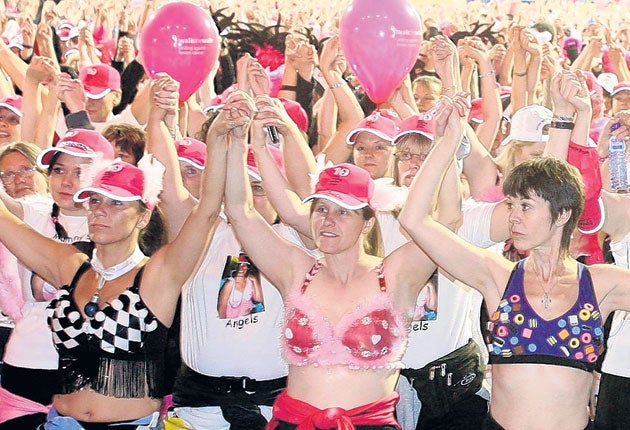Breast cancer death rate tumbles to a record low
The headline figures are good, but Jeremy Laurance says the battle is far from won

It is difficult to know whether to laugh or cry at the latest figures relating to breast cancer. Britain's cancer community was celebrating yesterday after the charity Cancer Research UK reported that deaths from the disease have fallen to a record low.
In 1971, the first year statistics were collected, 12,472 women died from the disease and over the next 18 years the death toll steadily mounted, peaking at 15,625 in 1989. Since then the death rate has plummeted bringing the number of women dying below 12,000 for the first time in 2007, to 11,990. More than three out of four women diagnosed with breast cancer survive more than five years today, compared with half in the early 1970s.
That is undoubtedly good news. But there is another, less happy side to the story. While the death rate has fallen, the incidence of the disease has soared, doubling since 1971 to over 45,000 cases a year. Breast cancer is now Britain's most common cancer, even though it principally affects only one sex (there are a few hundred male cases per year).
The fall in the death rate is all the more remarkable because it has occurred at a time when the incidence of the disease has risen dramatically. But while that is testament to medicine's success, the increasing incidence of the disease is evidence of its failure.
A generation since statistics on the disease were first collected, and after the expenditure of billions of pounds on research and treatment, we have twice as many women being struck by the disease and almost the same number dying. That's a funny kind of progress.
In the mid-1980s, Britain's death rate from breast cancer was the highest in the world. Since then it has fallen faster and further than in comparable countries. The main reason has been the recognition that the earlier cancer is diagnosed the easier it is to treat and that women treated by a breast cancer specialist (as opposed to a general surgeon) have a better chance of survival.
Screening to aid early diagnosis, improvements in surgery, chemotherapy and radiotherapy and longer-term use of hormonal treatments such as tamoxifen and anastrozole, which cut the chance of cancer recurring by half, have all contributed. Professor Peter Johnson, Cancer Research UK's chief clinician, said: "It's incredibly encouraging to see fewer women dying from breast cancer than at any time in the last 40 years, despite breast cancer being diagnosed more often. We hope the figures will encourage women over 47 to attend screening and to know if a tumour is found, their chances of beating it are better than ever."
Against this, however, the disease has followed a relentless upward trend, driven by rising prosperity and modern lifestyles. Similar increases have been seen in all developed countries, linked with exposure to the female hormone oestrogen, influenced by changes in reproduction – smaller families, delayed childbirth – and improved diet. Rising obesity and increased alcohol consumption have also contributed.
One woman in nine develops breast cancer. The falling death rate shows Britain is at last getting it right on treatment. But the question the figures raise is whether the focus of research should now shift to preventing the disease that is feared more than any other.
Subscribe to Independent Premium to bookmark this article
Want to bookmark your favourite articles and stories to read or reference later? Start your Independent Premium subscription today.

Join our commenting forum
Join thought-provoking conversations, follow other Independent readers and see their replies